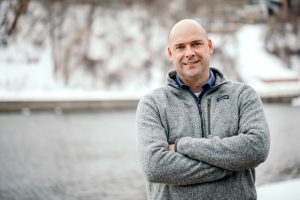
In the 1940s, the 3M Corporation and DuPont developed PFCs (now called PFAS, for per- and polyfluoroalkyl substances), some of the most resilient chemicals ever created. They were perfect for a variety of industrial and consumer products, including non-stick cookware, stain and water repellents for clothing and furniture (Scotchguard), fast food wrappers, and even a specialized foam to fight petroleum fires, called aqueous film-forming foam (AFFF), used across the world at airports and military bases.
“Often what makes a chemical great for industry, makes it not so great for the environment,” says environmental chemist and School of Public Health Associate Professor Matt Simcik.
In the late 1990s, studies began to show that PFAS were everywhere around the globe, including in water, soil, wildlife, and our own bodies.
Their widespread use in food packaging, processing equipment, manufacturing, and commercial household products gave them unlimited avenues into living organisms and the environment — where they persist and accumulate. As products containing PFAS degrade, they release the chemicals into the soil and water. Drinking water can be contaminated where communities have a water source near a facility where PFAS were manufactured or used.
What you don’t know, can hurt you
Whether PFAS pose a risk to human health remains uncertain, though they have been linked to cancer and immune dysfunction. A recent Harvard study found them to be “obesogens” that can interfere with human weight regulation and thus contribute to the obesity epidemic. A 2014 School of Public Health study of 3M employees who worked with PFAS found no damage from their contact with the chemicals, but Simcik feels we just don’t have enough information to declare them safe.
“We don’t know yet what they might do to a developing fetus, for example,” he says. “We know they affect lipid levels in the liver and blood, and those levels are really important in fetal brain development. My fear about PFAS is that we just haven’t figured out how they harm us.”
By 2002, 3M had stopped making PFAS in their original form. Traditionally, they contained a chain with 8 carbon atoms; today PFAS have 4 and 6 carbons in the chain. According to Simcik, the new shorter versions don’t break down any better in the environment, but we eliminate them easier from our bodies. China continues to manufacture 8-carbon PFAS, but the U.S. has banned the import of products containing this form.
The best thing for the environment and for humans is to keep PFAS out of lakes, streams, or wastewater treatment plants. But until now, no one had yet discovered a simple and inexpensive way to do that.
A clean solution for a pervasive problem
In 2011, the Department of Defense (DoD) issued a challenge: It wanted to remediate PFAS contaminated groundwater near military bases that had used AFFF to fight fires (the Air Force alone has 370 contaminated sites) and called for proposals that presented potential solutions. The School of Public Health’s proposal was one of four to receive DoD funding.
Simcik knew that no one had found a way to destroy PFAS in groundwater, but he did have an idea for how to keep them from traveling through aquifers to drinking water sources.
Ramona (Johnson) Caswell, one of Simcik’s School of Public Health Master of Science students, was exploring how PFAS move through groundwater by sticking to mineral particles, like soils, clays, and iron oxides. And UMN Civil Engineering PhD student Feng Xiao, whom Simcik was co-advising, was looking at how a common water-purifying process called coagulation could help PFAS adhere to those particles so the contaminant could be removed from drinking water.
When PFAS filter down into the groundwater, they become part of a plume that flows toward a water source, like the Mississippi River. Simcik hypothesized that if you could introduce a coagulant — a non-toxic compound used every day in drinking water treatment — into that plume to help the PFAS adhere to larger particles, you could create a barrier that would contain the PFAS, but let clean water flow through.
Bench to field
With Caswell and Xiao’s research as a foundation, Simcik and water resources science PhD candidate Yousof Aly developed a model of the containment process in the lab using a proprietary coagulant.
“The idea of our work is to keep PFAS bottled up while other people are figuring out ways to destroy them underground,” says Simcik. “In the meantime, we’ve kept the PFAS in the groundwater plume from migrating off military bases and into drinking water supplies.”
The next step, with another potential round of DoD funding, is to take the process into the field.
“We know it works in the lab and now we’d like to test it in a real-world situation,” says Simcik.
Simcik is working with the University of Minnesota’s Office for Technology Commercialization in an effort to patent different applications of the containment process other than the way it may be used at DoD sites. He believes that his method can be used to sequester PFAS in systems like lakes, streams, and rivers, and wastewater treatment plants, as well as Minnesota landfills that receive 3M waste.
“With this process, I’m using the same chemical principles that went into creating these contaminants to remove them from the environment,” says Simcik.
As a person with a lifetime love of the outdoors and a scientist who has spent his career protecting the environment, Simcik is particularly motivated to give his own children and future generations the opportunity to live free from harmful exposures in the natural world.
